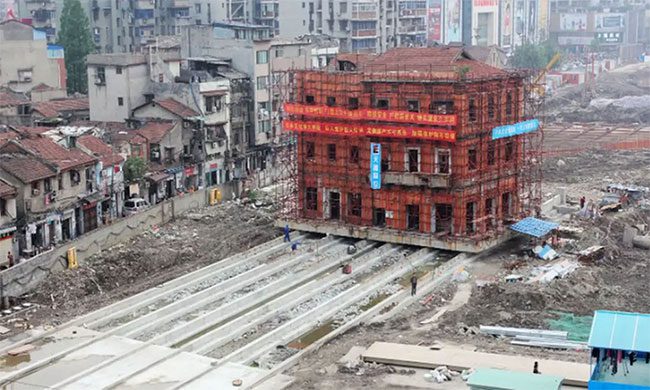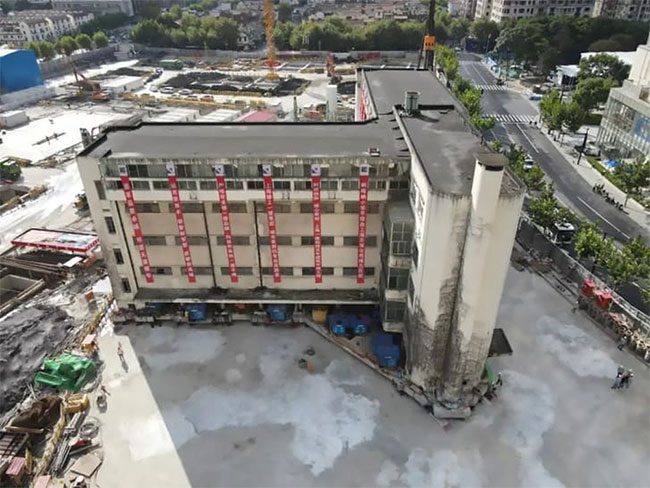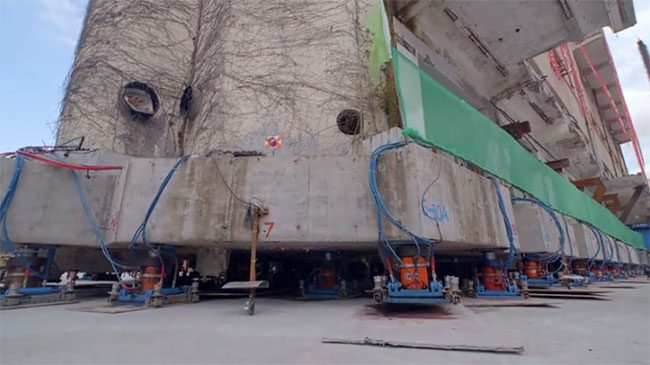The residents of Shanghai were both surprised and astonished to witness a massive building moving on foot to a new location. However, this is not the first time such a strange event has occurred.
Ancient Buildings Weighing Thousands of Tons “Walking”
On July 8, 2022, the people of Shanghai witnessed a 3,800-ton ancient building being moved along the streets on supports, designed by architects to relocate the structure.
The entire 3,800-ton building was lifted off the ground and moved with the help of a technology known as the “walking machine.” The building was returned to its original position on July 8 as part of a renovation project.
It was one of the largest and heaviest architectural structures ever moved in the city while maintaining its original state.

100-year-old structure, weighing 3,800 tons relocated using supports in Shanghai, China – (Photo: NEWSTRACK ENGLISH).
In 2020, residents of Shanghai, China were amazed to witness a building that literally “walked.”
Shanghai Lagena Primary School, which is 85 years old, was lifted off the ground, its foundation raised, and relocated using newly developed technology dubbed “the walking machine.” Engineers attached nearly 200 mobile supports beneath the five-story building, according to Lan Wuji, the project’s chief technical supervisor.

An aerial view of the Shanghai Lagena Primary School building. (Source: Shanghai Evolution Shift Project).
The supports were divided into two groups that alternately lifted and lowered, mimicking human walking. Lan Wuji from Shanghai Evolution Shift developed the new technology in 2018 and stated that attached sensors help control how the building moves forward.
“It’s like giving the building crutches so it can stand up and walk,” he said.
There are several methods to move a building: For instance, a building can slide down a set of tracks or be pulled along by vehicles. However, the Lagena Primary School, weighing 7,600 tons, posed a new challenge – its T-shape, while previously moved structures were square or rectangular, according to Xinhua News Agency. Lan Wuji noted that the unusual shape meant traditional pulling or sliding methods might not be effective as it might not withstand lateral forces acting on it.
The building also needed to be rotated and follow a curve during relocation instead of just moving straight – another challenge that required a new approach.
This operation is part of the city’s efforts to preserve historical structures. The supports operate similarly to robotic legs.

The building moving step by step with the aid of support devices.
According to a statement from the Huangpu District government, the Lagena Primary School was built in 1935 by the city council of the former French Concession in Shanghai. It was relocated to make way for a new commercial and office complex, scheduled for completion in 2023.
Wuji explained that workers first had to excavate around the building to install 198 mobile supports in the gaps beneath. After the building’s columns were trimmed, the robot “legs” were then extended upwards, lifting the building before moving it forward.
Over 18 days, the building was rotated 21 degrees and moved 62 meters (203 feet) to its new location. The relocation was completed on October 15, 2020, with the old building set to become a heritage preservation and cultural education center.
This project marked the first time the “walking machine” method was used in Shanghai to relocate a historical building.
Efforts to Preserve Historical Buildings
In recent decades, China’s rapid modernization has seen many historical buildings demolished to make way for skyscrapers and modern office buildings. However, there is growing concern about the architectural heritage disappearing across the country.
Some cities have launched new conservation campaigns, sometimes including the use of advanced technologies that allow the relocation of old buildings instead of demolition.
Lan, who supervises the Lagena Primary School project, stated, “Relocation is not the first option, but better than demolition. I don’t want to touch historical buildings.”
He added that to relocate a monument, companies and developers must go through strict regulations, including obtaining approval from various levels of government.
However, he mentioned that relocating a building is “a viable option.” “The central government is placing more emphasis on protecting historical buildings. I am pleased to see this progress in recent years.”
Shanghai is considered the most progressive city in China regarding heritage conservation. The presence of some buildings from the 1930s in the famous Bund district and the “shikumen” (stone gate) houses from the 19th century in the Xintiandi area being refurbished provides examples of how to breathe new life into old buildings, despite some criticism of how this redevelopment has been carried out.
The city also has a track record of relocating old buildings. In 2003, the Shanghai Concert Hall, built in 1930, was moved over 66 meters (217 feet) to make way for an elevated highway. The Zhengguanghe building – a six-story warehouse, also from the 1930s – was later moved 125 feet (38 meters) as part of local redevelopment in 2013.
More recently, in 2018, the city relocated a 90-year-old building in Hongkou District, considered the most complex relocation project in Shanghai to date, according to Xinhua News Agency.
Wuji added, “In my 23 years of working in this field, I haven’t seen any other company able to move structures along a curve.”
Xinhua News Agency reported that experts and technicians met to discuss possibilities and test various technologies before deciding on the “walking machine” option.
Lan Wuji could not provide the exact cost of the project, stating that the cost of relocation varies case by case, according to CNN.
“It cannot be used as a reference because we have to preserve the historical building at all costs,” he said. “But generally, it is cheaper than demolishing and then rebuilding entirely at a new site.”


















































